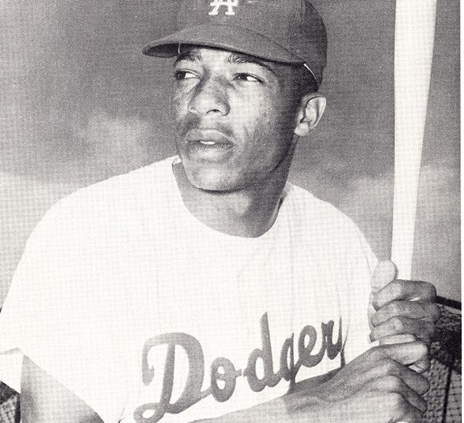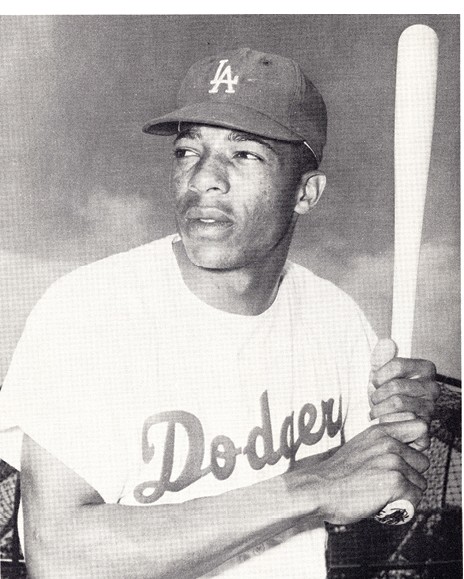September 2, 1969: Willie Davis sets Dodgers record with a hit in 31st consecutive game
Dodgers center fielder Willie Davis won three Gold Gloves and hit in a franchise-record 31 straight games in 1969. (SABR-Rucker Archive)
Throughout the month of August 1969, the Los Angeles Dodgers were battling for the National League West Division crown. All season the NL West had been a close race between five teams, everybody except the expansion San Diego Padres. Nobody had been hotter for the Dodgers in August than veteran center fielder Willie Davis.
William Henry Davis was born in Arkansas but went to high school just three miles away from Dodger Stadium. He was a high-school track star but loved baseball and was signed by Dodgers scout Kenny Myers upon graduating from Theodore Roosevelt High School.1 Within two years he became the starting center fielder, replacing Duke Snider, in 1960.
The first year of the new National League West Division was a wild one, with five of the six teams within 3½ games of first place on August 1. The Dodgers entered the month in second place, two games behind Atlanta. Coming into August play, Willie Davis was hitting .260, and had just struggled through an 0-for-6 game vs. Pittsburgh on July 31. The next game he borrowed teammate Ken Boyer’s larger 40-ounce bat, hoping to get more wood on the ball. His usual bat was 30 ounces and he had to choke up about four inches on Boyer’s bat. As well, he stood back farther from the plate and told reporters, “I’ve cut down on my swing.”2
A month later, Davis had hit in 30 straight games, tying the Dodgers’ 53-year-old franchise record for the longest hitting streak, set by Zack Wheat of the 1916 Brooklyn Dodgers. He batted .459 for the month and was the NL Player of the Month. If he got a hit in the September 2 game against the Mets, he would own the record.
It was a pleasant 76 degrees for the afternoon game against the Mets who were losing ground to the East Division-leading Chicago Cubs. Even Dodgers owner Walter O’Malley was getting caught up in the excitement. “When Koufax pitched his no-hitters, we gave him $500. When Drysdale pitched the 56 consecutive scoreless innings, we gave his wife a string of 56 pearls. We will have something very appropriate for Willie should he break the National League record,” O’Malley said, adding, “This season is going to be his financial turning point.”3
Mets first baseman Donn Clendenon started the scoring early with a first-inning blast into the right-field seats off Dodgers starter Don Sutton (15-12). The previous night the Dodgers had exploded for five runs in the first inning and made sure starter Jerry Koosman didn’t get past the fifth batter. Mets starter Gary Gentry (9-11) was a much different proposition.
Through the first five innings the Dodgers hitters were unable to put much offense together. Gentry scattered three hits and walked one. In the first inning Davis grounded out to shortstop and in the fourth inning he struck out.
In the Mets’ fourth, Clendenon hit his second home run of the game (his 11th of the year) and was providing all the offense in the game until the sixth inning, when the bats started to show for both teams. Mets third baseman Wayne Garrett led off the top of the inning with a single to center field. Clendenon grounded out and Garrett took second. Sutton intentionally walked Art Shamsky. Second baseman Ken Boswell followed with a single to right field. With the bases loaded, Mets right fielder Ron Swoboda doubled to right-center. Garrett and Shamsky scored easily, but Boswell was thrown out at the plate by center fielder Tommy Agee, and Jerry Grote flied out. It was 4-0, Mets after 5½ innings.
The top of the Dodgers’ batting order was now coming up, and the LA fans were hoping to see some offense. But Maury Wills grounded out and Manny Mota flied out. That brought up Davis making his third attempt to break Zack Wheat’s record. Davis wasted no time breaking the Dodgers record and tying Stan Musial for the longest National League hitting streak in the last 30 years. He hit Gentry’s first pitch to left-center field for a double. The Dodger Stadium crowd roared, and the scoreboard showed this note:
“BEFORE TONIGHT’S GAME WILLIE DAVIS GOT A WIRE WHICH READ ‘CONGRATULATIONS – KEEP GOING YOU HAVE DONE A REAL JOB’
IT WAS FROM SUNRISE BEACH-MO AND WAS SIGNED ‘ZACK WHEAT.’”4
Wheat, 81 years old at the time, told Dodgers vice president Red Patterson that he was rooting for Davis to break his record. Wheat reminded Patterson that during his streak he was robbed of a hit by the first-base umpire in game 30 and then went on to get hits in the next 11 games. “I should have reached 41 games,” he said.5
The next batter was first baseman Wes Parker, whose single to center scored Davis with the Dodgers’ first run. Left fielder Willie Crawford followed with a single, but catcher Bill Sudakis grounded out to Boswell, ending the inning.
The Mets went down in order in the seventh. The bottom half started with promise for the Dodgers with a single up the middle by catcher Tom Haller. The next three hitters – second baseman Ted Sizemore, pinch-hitter Len Gabrielson, and Wills – were not able to make anything happen.
In the top of the eighth Clendenon got his third hit, a single to left off reliever Joe Moeller with one out. He stole second base and scored two batters later on Boswell’s single to center field, giving Mets starter Gentry a 5-1 cushion.
In the Dodgers’ eighth, Gentry continued to dominate, making quick work of Mota, Davis, and Parker.
Moeller returned to the Dodgers mound for the ninth and kept the score unchanged after a groundout by catcher Jerry Grote, a walk to shortstop Bud Harrelson, a foul third-strike bunt by Gentry, and a groundout to third by center fielder Tommie Agee.
Willie Crawford opened the Dodgers’ ninth with a walk. Bill Sudakis popped out, but Tom Haller singled to right field. Von Joshua, making his major-league debut, ran for Haller. Mets manager Gil Hodges pulled Gentry and brought in righty reliever Ron Taylor, who was having a very productive season in the Mets bullpen. Taylor got Sizemore to ground out but then gave up singles to pinch-hitter Jim Lefebvre (pinch-runner Bobby Valentine, also making his major-league debut, ran for him), Maury Wills, and Andy Kosco. This sudden awakening of Dodgers bats brought in three runs and made the score 5-4, bringing up Willie Davis to face Mets closer Tug McGraw.
Davis was not able to solve McGraw, who earned his 10th save of the season by getting Davis to foul off two pitches and then swing and miss on a low curveball. “The pitch was low,” said Davis. “He threw me a breaking ball inside. Last time he did that I hit it. I don’t know how I missed. I just wish we could have won the game.”6
After the game Davis was asked about challenging Joe DiMaggio’s 56-game streak. His reply: “You don’t fool with Joe D.”7
The streak continued for one more game when Davis doubled in the winning run off Mets reliever Jack DiLauro in the bottom of the ninth the next day. It ended the day after when San Diego pitchers Dick Kelley and Gary Ross held the Dodgers to four hits and none for Davis. “It was great while it lasted,” Davis said. “All I can do now is start again tomorrow and hit in every game for the rest of the season.”8
Davis’s 31-game hitting streak had been the longest in the majors since Dom DiMaggio of the Boston Red Sox hit in 34 consecutive games 20 years before. Davis’s streak as of 2024 was still the longest in the 140-year history of the Dodgers franchise.
Sources
In addition to the sources cited in the Notes, the author consulted Baseball-Reference.com and Retrosheet.org.
https://www.baseball-reference.com/boxes/LAN/LAN196909020.shtml
https://www.retrosheet.org/boxesetc/1969/B09020LAN1969.htm
Notes
1 Stephen Booth, “Willie Davis: Disappointment or Misunderstood?” Fangraphs.com, May 26, 2011. https://tht.fangraphs.com/willie-davis-disappointment-or-misunderstood/.
2 Mike Bryson (Associated Press), “Wondrous Willie Davis Extends Hitting Streak,” Durham (North Carolina) Sun, September 1, 1969: 18.
3 Ross Newhan, “Davis Ties Mark as Dodgers Win,” Los Angeles Times, September 2, 1969: 39.
4 AP Wirephoto caption, “Message From the Past,” Stockton (California) Record, September 3, 1969: 41. The text reads as it was presented on the message board.
5 “Dodger Notes,” Los Angeles Times, September 3, 1969: 46.
6 Associated Press, “Davis Sets Hitting Mark, but Fans in Crucial Spot,” Tucson Daily Citizen, September 3, 1969: 31.
7 William F. McNeil, The Dodgers Encyclopedia (New York: Sports Publishing, 2012), 380.
8 Ross Newhan, “Padres Shut Out Davis, Dodgers,” Los Angeles Times, September 5, 1969: III-1, 4.
Additional Stats
New York Mets 5
Los Angeles Dodgers 4
Dodger Stadium
Los Angeles, CA
Box Score + PBP:
Corrections? Additions?
If you can help us improve this game story, contact us.



